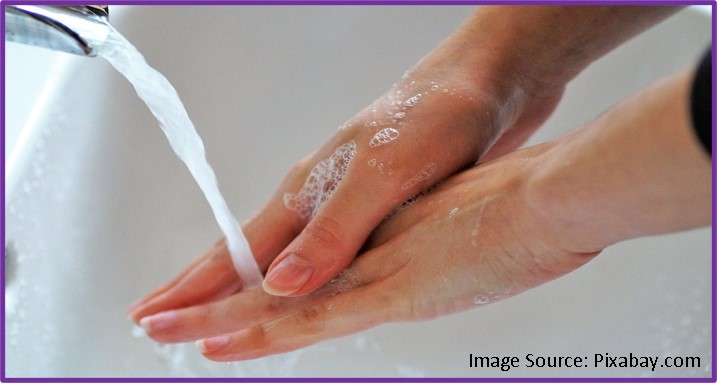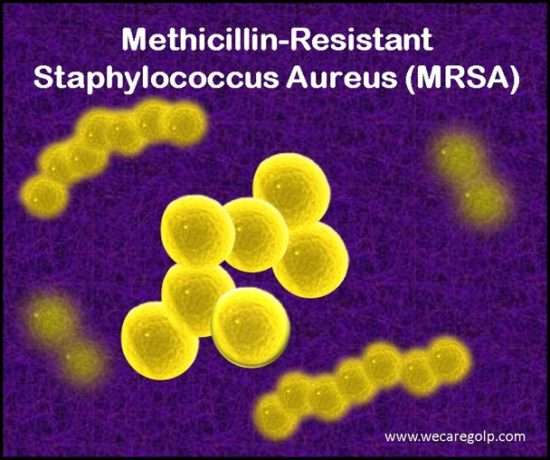Introduction
Methicillin-resistant staphylococcus aureus (MRSA) is a group of opportunistic pathogens that has emerged as a widespread cause of both community- and hospital-acquired infections.
- MRSA is a group of Gram-positive bacteria that are genetically distinct from other strains of staphylococcus aureus.
- The infection by MRSA is difficult to treat because of resistance to most β-lactum antibiotics (such as methicillin).
- MRSA infection is usually limited to skin but it can be life threatening if it spreads to the lungs, the blood stream, or other organs.
Types of MRSA
Health-care-associated MRSA (HA-MRSA)
- Infections that occur in people that are contracted in hospitals or healthcare settings such as hospitals, nursing homes, and dialysis center are known as Health-care-associated Methicillin-resistant staphylococcus aureus infection (HA-MRSA).
- This type of infection is associated with an invasive procedure, contact with wounds, or contaminated hands.
- Infection can spread through contaminated linens or poorly sanitized instruments.
- It can cause severe problems such as blood infection and pneumonia.
Community-associated MRSA (CA-MRSA)
- The infections are transmitted through close personal contact (or direct contact with infected wounds). Community-associated MRSA infection may develop because of poor hygiene.
Incidence
- According to the Centers for Disease Control and Prevention (CDC), 1 in 3 people carry Staph bacteria in their nose and 2 out of 100 people carry MRSA.
- There are more than 80,000 cases of MRSA each year and more than 11,000 people die from these infections.
Mode of Tansmission of MRSA
- MRSA is often transmitted through direct contact with the infected wounds or can be transmitted through contaminated surfaces or items such as sports, equipment, wound dressing, towels, or linens.
Causes of MRSA
- MRSA results from infection with bacterial strains that have acquired resistance to particular antibiotics.
Who are at Risk for MRSA infection?
MRSA infection can occur in any healthy people who have not been admitted or visited hospital. People who may be at risk include
- Athletes or others who share exercise equipment, towels, and razors with other people
- People who had surgery in the past year
- Children in daycare
- People who inject illegal drugs
- People who live in crowed or unsanitary conditions
- Members of the military
- People who have gotten tattoos
- People who regularly undergo hemodialysis
- People who have a weak immune system due to other medical conditions
- Recent influenza infection
- Homosexual Men have a higher risk of developing MRSA infection
Incubation Period
- The incubation period is often indefinite if the organisms colonize (not infect) an individual.
- The incubation period for MRSA ranges from 1 to 10 days if it enters broken skin or damaged mucous membranes.
Signs and Symptoms of MRSA
Symptoms of MRSA skin infections includes
- Bump that is painful, red leaking fluid, or swollen. It may look like a spider bite, pimple or boil.
- Bumps under skin that are swollen or firm
- Skin around a sore that is warm or hot
- Painful sore along with fever
- Bump that get bigger quickly or does not heal
- Rash or fluid blisters
- Boil or abscess that leaks fluid.
Signs of systemic infection includes
- Fever
- Chills
- Severe headache
- Sleepiness
- Dizziness or fainting
- Shortness of breath
- Muscle aches
- Chest pain
Pathophysiology of MRSA
- Staphylococcus aureus is a commensal pathogen that colonizes the skin, nose, and throat of humans and is common in immune-compromised patients, intensive care unit patients, pneumonia patients, and viral infections.
- Methicillin resistance is mediated by the gene mecA as it encodes penicillin-binding protein 2a (PBP2a), an enzyme responsible for crosslinking the peptidoglycans in the bacterial cell wall.
- PBP2a has a low affinity for β-lactam, and thus develops resistance to this entire class of antibiotics.
- As a result, the bacteria proliferate unchecked resulting in colonization and infection, ranging from mild to life-threatening infections, such as skin and soft tissue infection (SSTI), pneumonia, osteoarticular infections, toxic shock syndrome and bacteremia.
Diagnosis of MRSA
- Medical history assessment and physical examination.
- Wound culture-Analysis of wound samples taken with a sterile cotton swab for the presence of Staph bacteria.
- Sputum culture-Analysis of sputum culture shows the presence of bacteria, cell fragment blood, or pus.
- Blood culture– blood culture indicates the blood infection (sepsis). Bacteria can enter the blood from an infection located in other parts of the body such as the lungs, bones, and urinary tract.
Treatment of MRSA
The types of treatment depend on the location and types of infection, the severity of the symptoms, and the antibiotics to which the strains of MRSA respond.
- Oral antibiotics can treat milder infections.
- Antibiotics choice is based on the severity of illness at presentation, clinical judgment, and regional susceptibilities of the strain.
- Severe infections may require intravenous antibiotics treatment as per the doctor’s prescription.
- Cloxacillin or cefazolin remain appropriate empirical antibiotics choices for moderate infection.
- Skin infection requires incision and drainage following the aseptic technique for the treatment.
Complications of MRSA
Methicillin-resistant Staphylococcus aureus (MRSA) infections can occur at various sites and may be serious, even life-threatening complications of MRSA infections are:
- Bone infection (osteomyelitis)
- Joint infection (septic arthritis)
- Heart infection (endocarditis)
- Pneumonia
- Sepsis
- UTI (urinary tract infection)
- Surgical site infection
Precaution

Standard infection control precautions (SICPs) in routine practice minimize the spread of infection, and it includes following steps:
- Source control– contact precautions should be used with the patient with known or suspected infections. Single-patient rooms may be used with designated toilets and sinks. Maintaining a distance of 2 meters may be used when a respiratory infection is present.
- Hand hygiene-Hand hygiene can be maintained by using alcohol-based hand rub or with soap and water before and after handling patient or patient-related items.
- Gloving– Gloving should be done while touching blood, body fluids, and contaminated items. Remove gloves between patient contacts and clean hands immediately.
- Masking-proper wearing of a mask, face shield, and visor is necessary during the procedures because there is a high chance of splashing droplets of respiratory secretions, blood or body fluids.
- Gowning– wear long-sleeved cuffed gown to prevent soiling from contamination.
- Patient care equipment– Proper cleaning, disinfecting, and sterilization of patient care equipment and rooms limit the transmission of the organism. Surfaces that are more likely to touch such as bed rails, tables, call bells, door knobs, etc. should be cleaned/disinfect more frequently.
- Education of patient, families, and visitors– People involved in patient care should be educated about the transmission of diseases and the importance of precaution that helps limit the infection.
Prevention of MRSA
Preventing health-care-associated MRSA (HA-MRSA) infection
Following guideline can help patient health care workers and visitors to prevent MRSA infections from spreading.
- Screening– Isolation of patients with MRSA infection from those without is best to prevent transmission. Rapid culture and sensitivity testing identifies carriers and reduces infection rates.
- Hand washing– Follow proper and strict hand washing technique before and after handling the patient with soap and water or an alcohol–based sanitizer.
- Cover any wound with a clean dressing.
- Isolation-Patient with wound drainage should be automatically put on contact precaution. Workers with active infections are excluded from activities where skin-skin contact is likely to occur.
- Laundry materials of the affected person should be washed separately with dilute bleach solution to reduce bacterial infection.
- Restricting Antibiotics use– Reducing the use of antibiotics that promote MRSA colonization, especially fluoroquinolones, glycopeptides, and cephalosporins. Care should be taken when draining boils, because disruption of surrounding tissue leads to larger infections, including infection of bloodstream. Wound should be covered with clean dressing.
- Visitors and healthcare workers handling and taking care of infected persons in isolation need to wear protective garments.
- Follow the advice of healthcare workers about using or caring for catheters and other devices.
- Proper disposal of dressings and other contaminated items is required.
- Hospital room, surface equipment, and laundry items need to be properly disinfected.
Preventing Community-associated MRSA infection
- Proper hand washing- Careful hand washing is the best defense against germs. Hand washing should be done for at least 20 sec following the proper technique.
- Keep wounds covered-cuts and scrapes should be covered with clean, dry bandages until they heal. The pus from the infected wound may contain MRSA, covered wound helps to prevent the spread of bacteria.
- Avoid popping or pricking spots or lesions.
- Avoid sharing personal items such as towels, bed sheets, razors, clothing, and athletic equipment.
- Shower immediately after each game with soap and water.
- Use of disinfectants, detergents, and other sanitizing products to keep the surface clean.
Summary
- Methicillin-resistant Staphylococcus aureus (MRSA) is a cause of Staph infection, which is difficult to treat because of resistance to some antibiotics.
- MRSA infection can spread in hospitals, healthcare facilities, and the community where we work and live.
- The symptoms of infection depend on the site of involvement. It may start with mild infections and can lead to serious skin infections, and blood infections.
- Proper management and treatment help to heal the wound soon.
- Infection control is the key to stopping the spread of MRSA infections.
References
- Singhal T, Rodrigues C, Soman R, Wattal C, Swaminathan S, Nambi S, Talwar D, Singh RK, Todi S. Treatment of MRSA infections in India: Clinical insights from a Delphi analysis. Indian Journal of Medical Microbiology. 2022 Jan 1;40(1):35-45.
- Chalmers SJ, Wylam ME. Methicillin-Resistant Staphylococcus aureus Infection and Treatment Options. Methods Mol Biol. 2020;2069:229-251. doi: 10.1007/978-1-4939-9849-4_16. PMID: 31523777.
- Lee, A., de Lencastre, H., Garau, J. et al. Methicillin-resistant Staphylococcus aureus. Nat Rev Dis Primers 4, 18033 (2018). https://doi.org/10.1038/nrdp.2018.33
- Barton, M., Hawkes, M., Moore, Et. aL. Guidelines for the prevention and management of community-associated methicillin-resistant Staphylococcus aureus: The Canadian journal of infectious diseases & medical microbiology = Journal canadien des maladies infectieuses et de la microbiologie medicale, 17 Suppl C (Suppl C), 4C–24C.
- Centre for disease control and prevention- methicillin-resistant staphylococcus https://www.cdc.gov/mrsa/index.html
- https://www.mayoclinic.org/diseases-conditions/mrsa/symptoms-causes/syc-20375336

